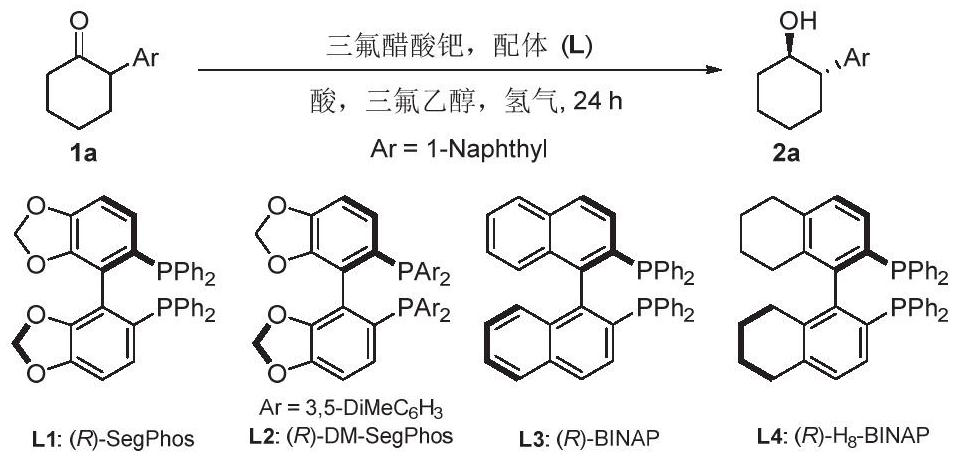Synthesis method of chiral trans-2-substituted naphthenic alcohol
A cycloalkanol and chiral technology, applied in the field of asymmetric hydrogenation synthesis, can solve the problem of low diastereoselectivity, and achieve the effects of improving enantioselectivity, accelerating racemization, and high enantioselectivity
- Summary
- Abstract
- Description
- Claims
- Application Information
AI Technical Summary
Problems solved by technology
Method used
Image
Examples
Embodiment 1-16
[0035] The optimization of embodiment 1-16 hydrogenation reaction conditions
[0036] Under nitrogen atmosphere, drop into metal palladium precursor (2.5~5mol% of substrate consumption) and chiral bisphosphine P-P * Ligand (3~6mol% of the amount of substrate), add acetone (1.0~2.0mL), stir at room temperature for 1h, remove the solvent under reduced pressure, and obtain the catalyst chiral palladium bisphosphine P-P * complex, then bring the catalyst into the glove box, dissolve the catalyst with the organic solvent used in the hydrogenation reaction, and transfer to the reaction bottle containing the acid additive (20-200mol% of the amount of the substrate) and the substrate (0.2mmol) Then put the reaction bottle into the reaction kettle, feed hydrogen gas (100-800psi), and react at 30-80°C for 20-72 hours; after the reaction is completed, hydrogen gas is slowly released, the solvent is removed under reduced pressure, and column chromatography separates Obtain pure product, ...
Embodiment 17-36
[0042] Synthesis of chiral trans 2-substituted cycloalkanols (2 in the structural formula) by asymmetric hydrogenation of 2-substituted cyclic ketones (1 in the structural formula)
[0043] Under nitrogen atmosphere, put metal palladium precursor (5mol%) and chiral bisphosphine P-P into the reaction bottle * Ligand (6mol%), add acetone (2.0mL), stir at room temperature for 1h and remove the solvent under reduced pressure to obtain the catalyst chiral palladium bisphosphine P-P * complex, and then this catalyst was brought into the glove box, and the catalyst was dissolved with the organic solvent (3mL) used in the hydrogenation reaction, and transferred to a medium containing acid additive (50-200mol% of the amount of substrate) and substrate (0.3mmol). Then put the reaction bottle into the reaction kettle, feed hydrogen (100psi), react at 30-80°C for 24-48 hours; stop the reaction, then slowly release the hydrogen, remove the solvent under reduced pressure, and perform column...
Embodiment 17
[0047] Example 17 (-)-(1R,2S)-2-(1-naphthyl)-cyclohexanol (2a): 62 mg, 91% yield, white solid, known compound (Eur.J.Org. Chem.2005,1354), R f =0.44 (n-hexane / dichloromethane / ethyl acetate 2 / 2 / 0.1), 97% enantiomeric excess, [α] 20 D =-75.32(c1.24, Methanol),[lit.(Eur.J.Org.Chem.2005,1354):[α] 20 D =-60 (c1.46, methanol) for 85% enantiomeric excess]. 1 H NMR (400MHz, CDCl 3 )δ8.20(d,J=8.4Hz,1H),7.92-7.84(m,1H),7.79-7.72(m,1H),7.56-7.45(m,4H),4.11-3.86(m,1H) ,3.53-3.26(m,1H),2.29-2.16(m,1H),2.04-1.89(m,2H),1.86-1.77(m,1H),1.64-1.46(m,5H) .13 C NMR (100MHz, CDCl 3 )δ139.7,134.2, 132.7,129.0,127.1,126.1,125.8,125.7,123.3,122.8,74.3,46.7,34.8,34.0,26.5,25.2. HPLC: ChiracelIC column, 230nm, 30℃, n-hexane / Isopropanol = 96 / 4, flow rate = 0.7mL / min, retention time 19.1min (major) and 20.4min.
[0048]
[0049] Cis-2-(1-naphthyl)-cyclohexanol (2a'): known compound (Tetrahedron: Asymraetry1995,6,1617), R f =0.50(n-hexane / dichloromethane / ethyl acetate 2 / 2 / 0.1), 1 H NMR (400...
PUM
 Login to View More
Login to View More Abstract
Description
Claims
Application Information
 Login to View More
Login to View More - R&D
- Intellectual Property
- Life Sciences
- Materials
- Tech Scout
- Unparalleled Data Quality
- Higher Quality Content
- 60% Fewer Hallucinations
Browse by: Latest US Patents, China's latest patents, Technical Efficacy Thesaurus, Application Domain, Technology Topic, Popular Technical Reports.
© 2025 PatSnap. All rights reserved.Legal|Privacy policy|Modern Slavery Act Transparency Statement|Sitemap|About US| Contact US: help@patsnap.com



